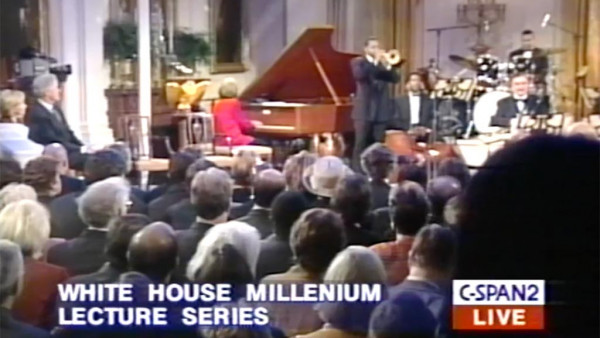Jazz at the White House: A Metaphor for Democracy (and a Help to the Boss)
It was everywhere, rustling through conversations the way a breeze moves through trees, in the smirks and jokes of some, in the extended, slightly nervous ovation the President and Mrs. Clinton received as they walked into the East Room of the White House on Friday night for a Millennium lecture on jazz. It was the President’s Problem, and it colored the event. The musicians onstage spent much of their time, as did the audience, analyzing the way the President and his wife interacted, how they played their public roles, how, in the middle of a Greek tragedy, they were doing.
And the Problem was on the President’s mind. When asked casually, at the reception after the music and the lectures, what role public art plays in a democracy, the President said, ‘‘Art is part of our better selves.’‘ Then he took a deep breath. ‘‘So much of public life is destructive nowadays,’‘ he said. ‘‘Things like this allow us to show our better side, not the dark, evil part of ourselves.’‘
The concert and lecture, the fourth this year in a series planned by the White House to bring together experts on a particular subject, had the trumpeter Wynton Marsalis and the pianist Marian McPartland as hosts. The audience of about 100 included the Czech President, Vaclav Havel; Secretary of State Madeleine K. Albright; Representative John Conyers Jr. of Michigan, and William J. Ivey, the chairman of the National Endowment for the Arts, along with some of jazz’s more important figures. The saxophonist Wayne Shorter showed up, as did the bassist Ron Carter; the saxophonist and band leader Illinois Jacquet; the head of the Institute of Jazz Studies, Dan Morgenstern, and the social critic Stanley Crouch.
Put together by a coalition of Jazz at Lincoln Center and the Thelonious Monk Institute in Washington, and broadcast on VH-1 and C-Span, the lecture included speeches by the President (who talked about how influential a whole series of musicians had been on his life, including Charlie Parker, Monk and John Coltrane), Hillary Rodham Clinton and President Havel. Mr. Marsalis and Ms. McPartland spoke, as did two jazz educators, Dr. Billy Taylor and David Baker. Ms. McPartland, Mr. Marsalis and Dr. Taylor played music that underscored their points. And a big band, made up mostly of members of the Jazz at Lincoln Center Orchestra, did some roaring.
The show was meant to to put jazz in its national and international context. At the end, questions were taken on the Internet from Britain, Canada and the United States.
There was some suspicion that the event had been put together to show that the President could continue with the life of the country despite the Problem. The event, organizers said, was planned some six weeks ago.
“Look, this event falls exactly in the place that Clinton has steadfastly maintained everything will fall,’‘ said Representative Conyers, a Democrat. ‘‘He has said that the personal attacks will not keep him from executing the rest of the term the way he wants to, which is to keep the nation going the way it should.”
There were some extraordinary moments, as well, that were nonmusical and not about the Problem. Mr. Havel, frail and a bit shaky, stood up and talked about how jazz had been a symbol of freedom in Czechoslovakia, how first the Nazis, then the Communists, had driven the music underground. “Music,” he said, “is the enemy of totalitarianism.”
Dr. Taylor, who had given a short lecture and demonstration of be-bop, heard something in what Mr. Havel was saying.
“If an American says something like that,’‘ he said, ‘‘we seem like we’re patting ourselves on the back. But he’s lived through something extreme, where the music was actually dangerous. We need to remember how powerful the music has been and how much resonance it has had internationally.”
And there were some strong moments musically, too, with the big band performing Duke Ellington’s “Harlem Airshaft,” swinging it thoroughly. Mr. Marsalis opened the musical portion of the lecture with a duet with Ms. McPartland on “St. Louis Blues” that had him tossing burred notes throughout the piece; it all led to his thesis, which bubbled through the entire lecture, that jazz is perfectly emblematic of democracy. The balance, goes the thesis, between the individual desires of the soloist and the necessity of the group is democracy in esthetic action.
Sherman Irby, an alto saxophonist in the big band, was watching the President.
“I looked at his eyes,” he said. “And I saw he was just another person, a regular man with lots of pressure on him. He’s normal and has his failures. But I also saw that he truly loved the music.”
Other musicians felt the same way. After the performance, a small group of musicians in the dark outside the White House waited for a ride back to the hotel.
“He’s the hippest President we’ve ever had,” said Eric Lewis, the pianist in the orchestra.
“He came up to me and asked me what kind of a saxophone I was playing,” said Victor Goines, also in the orchestra. “I said to him, ‘It’s a Julius Keilwerth, from Germany,’ and he said, ‘I have one of those.’ Really, we’re in our heyday. When he mentioned John Coltrane in his speech, he really meant it. I saw his script before the show, and John Coltrane wasn’t even mentioned. We’re in our heyday. We’d better appreciate it, because it may not last.”
By Peter Watrous
Source: The New York Times

